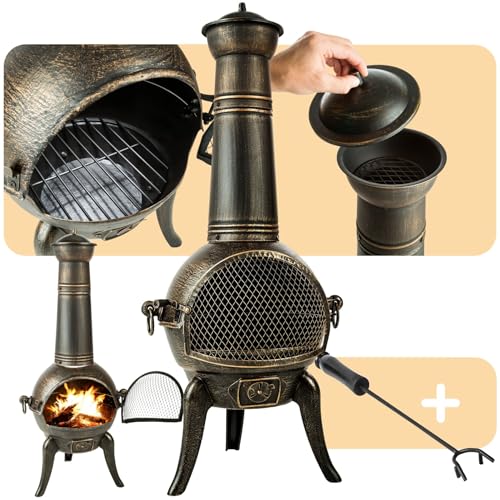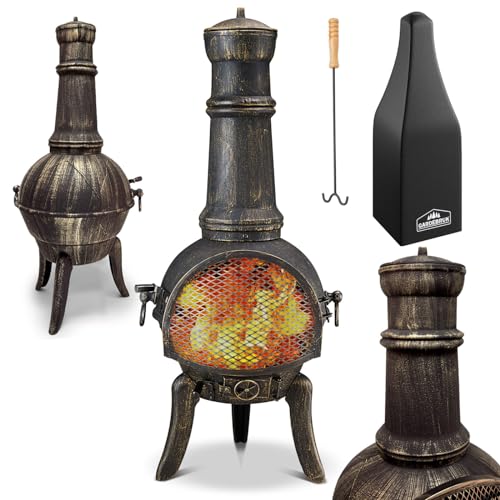13 Things About Chiminea Terracotta You May Not Have Known
페이지 정보

본문
 A Chiminea Terracotta Adds Warmth and Ambiance to Your Backyard Patio
A Chiminea Terracotta Adds Warmth and Ambiance to Your Backyard PatioChiminesas can provide warmth and charm to your backyard. Its chimney directs smoke upwards to prevent the flames and sparks from damaging surrounding plants and igniting your home or deck.
Chimineas made from clay should be broken up slowly. The first few fires should be slow-burning and small in size. The sealing of your chiminea, particularly in wet climate, is advised.
Material
A chiminea is a great way to add warmth and character to your backyard patio. The pot-belly design of the Chiminea is great for entertaining. However, innovative designs are now available to fit different styles of decoration. Although clay is the most well-known material, chimineas can be made from cast iron or aluminum. Each material type has its own benefits. While clay is simple to maintain but metal is more durable and better at enduring high temperatures.
When selecting a chiminea fire to purchase, consider its size, design and the type of fuel. The chiminea's size should be able enough to accommodate the amount of wood you use in order to maintain an even flame. The larger chimneys are suitable for large gatherings, while smaller models work best in intimate settings. A chimney focuses the smoke upwards to shield it from rain and strong winds.
The design of a chiminea is what makes it different from other fire pits that are used outdoors. The bowl-shaped base shields the flames from wind, rain and debris. The chimney is beautiful and allows you to control the size of flames.
Chimineas of clay are formed and molded by hand, then glazed at high temperatures. They are usually coated with a ceramic glaze in order to make them more attractive and resistant against weather damage. Some are decorated with Mexican-inspired designs. These chimineas are usually sold at garden stores and home improvement centers.
Before lighting a chiminea, it is recommended that you must cover the inside of the chiminea with coarse-grained gravel or sand. The sand helps reduce smoke and also prevents the clay from cracking during firing. After you've covered the base, you can place small pieces of kiln in the center. Use a natural fire lighter like this one from Amazon for a more efficient lighting.
When you are ready to cook Use a long-handled fork or spatula to turn the hot embers. You should not cook food directly on active flames as it could cause burning and blacken the food beyond recognition. Instead, begin with the smoking embers, and gradually build an enormous fire. Then, move the cooking pan to the top of the smoke stack.
Design
Chimineas look like an open-air stove, with a wide base and a long thin chimney to collect the smoke. The chimney shields the fire from rain and wind that could put out an open fire pit. Chimineas have been used for over four hundred years for gatherings as well as cooking and heating homes. Originally made of clay but now they are made in both traditional and contemporary designs, made of cast iron or Terracotta.
Modern chimineas might not have the traditional curves, but they feature a distinct chimney. They come in a variety of shapes and sizes. They vary between 12 and 16 inches diameter at the base and 25 to 30 inches in height (including the stand). The chimney is usually about 6 feet.
The height of a chiminea is crucial since it helps direct smoke upward, which can keep it from blowing on objects and people in your backyard or home. You can also make use of aromatic woods that smell great when they burn. This enhances the experience.
When choosing a chiminea to purchase, look for one that's constructed of a durable material that is able to withstand high temperatures. Beware of models that have decorative elements or other features that could crack or break under heat. If you decide to use a clay or terracotta chiminea, it should be seasoned by burning small amounts of wood for a period of three to four hours until the clay is able to become cured. The chiminea should be protected with a lid when not being used to prevent water from spilling onto the flames and burning.
Cast iron chimineas can withstand higher temperatures and rougher treatment because they are stronger and more durable than clay models. They also have more versatility and can be used to burn briquettes or coal in addition to wood. If you're looking for a classic style, go with an aluminized chiminea.
Regardless of the material you choose, make sure to place your chiminea inside a fire-proof area away from your home and furniture or plants. The chiminea should also be located at least 10 feet from any other structures such as fencing or sheds. Create a hearth for your patio by laying pavers across the space to serve as the platform for your chiminea and to make it easy to manage the fire.
Installation
A chiminea is a focal point for any gathering of the family and adds a new dimension to outdoor chiminea spaces. It is crucial to be aware of the requirements for maintenance of a chiminea before purchasing one. Cast iron chimineas last longer than clay chimineas made of traditional materials. However, they require slightly different maintenance due to their distinct design.
The base of the chiminea before. The bottom should be covered with sand, gravel or lava rock in order to protect it from direct contact with the fire. This will help reduce smoke and also prevent the chiminea from breaking.
It is also important to ensure that the chiminea is erected on the ground in a stable and safe place. Never place it on a deck or other flammable surface. If you must place it on a flammable area, use a metal grates to elevate the wood. This will shield the chiminea against the heat and sparks of the fire.
Before you light the Chiminea Barbecue for the first time, it needs to be seasoned by burning a few small chiminea fires in it. This will prevent the chiminea from cracking when you burn a lot of wood.
After each fire clean the chiminea thoroughly by using a wire-bristle brush or cloth. It is also important to get rid of any creosote or ash within the chiminea. If these chemicals are not removed, they could impact the quality of any subsequent fires you have in it.
The chiminea should be covered by a cover that protects it when it is not being used. This will prevent the clay from getting too wet and cracking or shrinking. Chimineas are prone to this type of damage when left continuously exposed to rain and snow.
Even in the summer, it's best to cover the chiminea. It is also an excellent idea to have a backup source of fuel for the fire, such as a propane tank or wood. It is also a good idea to keep a fire extinguisher in the vicinity to eliminate any sudden fires.
Maintenance
Despite the varying materials that chimineas are constructed from they all require regular maintenance to ensure that they last as long as possible. This involves cleaning the structure by applying protective coatings, and properly storing it in off-season to guard against extreme temperatures. These measures and basic guidelines for use can prolong the life of your Chiminea and reduce risks to safety.
Chimineas are made from clay and as such can crack when exposed to extreme temperature fluctuations. It is important to store your terra-cotta in a location that is dry and safe in the off-season. A cover will keep it safe from rain bbq and chiminea frost. It is also recommended to apply the sealant on your clay fireplace to protect it from the effects of moisture and temperature changes.
When cleaning a chiminea, it is essential to use non-abrasive tools and a soft cloth or brush to avoid damaging the clay surface. A bucket of water or a hose should be used to rinse off the surface after scrubbing, and it's important to allow the chiminea dry completely before re-using it. This will stop mold and mildew growth and keep it looking brand new.
If your chiminea has cracked section, it's essential to secure the broken pieces together, and then apply outdoor oven cement to the crack. It is available at the majority of hardware stores. It is applied using the help of a spatula or pointing trowel. It is essential to allow the cement to fully dry before lighting a test fire in the chiminea.
After the cement has dried, sand the damaged area of your chiminea medium coarse sandpaper to prepare it for repainting. It is then possible to paint it with a mixture of more or less any kind of emulsion paint for masonry or household use in a shade that complements the rest of your chiminea. If the chiminea has any corrosion or rust take it off by sanding the affected areas and then washing them with water to get rid of dust or dirt particles.

- 이전글20 Trailblazers Leading The Way In Electric Treadmill Sale 24.10.25
- 다음글Volkswagen Car Key Replacement Tools To Ease Your Daily Life Volkswagen Car Key Replacement Trick That Every Person Should Learn 24.10.25
댓글목록
등록된 댓글이 없습니다.